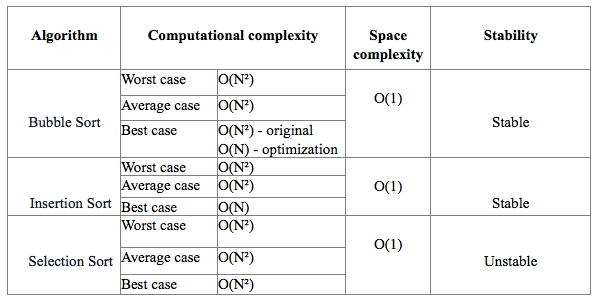
Whereas the original algorithm was O(n 2) for all the cases. But for the best case (Array already sorted) it will be O(n), For average case also the performance will see an improvement. Note, that if all the passes are performed, then our optimized algorithm will in fact perform a little slower than the original one. The comparison operator is used to decide the new order of element in the respective data structure. For this we can have a flag variable which is set to true before each pass and is made false when a swapping is performed. A Sorting Algorithm is used to rearrange a given array or list elements according to a comparison operator on the elements. If there is no swapping in a particular pass, it means the array has become sorted, so we should not perform the further passes. This is the optimization over the original bubble sort algorithm. Average Case Time Complexity Space Complexity Comparison with other Sorting Algorithms.

If we can identify, that the array is sorted, then we should stop execution of further passes. Suppose if the array is already sorted, then there will be no swapping (because adjacent elements are always in order), but still we will continue with the passes and there will still be (n-1) passes. While sorting is a simple concept, it is a basic principle used in complex computer programs such as file search, data compression, and path finding. It is generally one of the first algorithms taught in computer science courses because it is a good algorithm to learn to build intuition about sorting. Selection sort is noted for its simplicity, and also has performance advantages over more complicated algorithms in certain situations. Bubble sort is a simple, inefficient sorting algorithm used to sort lists.

It has O(n 2) complexity, making it inefficient on large lists, and generally performs worse than the similar insertion sort. Selection Sort: Selection sort is an in-place comparison sort. In the above example, the array got sorted after 2nd pass, but we will still continue with the 3rd, 4th pass. Bubble sort is not a practical sorting algorithm when n is large. So the array will be sorted after n-1 passes.Īlgorithm: void bubbleSort(int *arr, int n)Įxtra Space taken: O(1) – In-place algorithm. In the 3rd pass 3rd largest element will be moved to the (n-2)th position and so on.Īfter (n-1) passes, (n-1) elements will be moved to their proper positions, the last element has to be the smallest. I.e, 5 will be moved to the (n-1)th position. Now, in the 2nd pass, we will consider the first (n-1) elements only (because last position already has largest element). Then during first pass, adjacent elements will be compared, and swapped if not in order (if larger element is on left side) as shown below:Īfter first pass the largest element is at the last position. These are called passes, In the first pass the largest element moves to the last position (sorting in ascending order). To sort the entire array, the array is traversed n-1 time (array having n elements). Also suggest improvements which will improve the best case running time of Algorithm to O(n).īubble Sort is a sorting algorithm which compares two adjacent elements and swap them if they are not in the right order. Write algorithm of mention the Time & Space complexity of the Algorithm. If no elements were swapped in an iteration (i.e., swapped is false), the algorithm ends prematurely.What is Bubble Sort. The inner loop then compares two elements with each other up to the position max and swaps them if the left element is larger than the right one. Therefore, in the outer loop, we decrement the value max, starting at elements.length - 1, by one in every iteration. Selection sort is faster than Bubble sort. In selection sort, the sorted and unsorted array doesn't make any difference and consumes an order of n 2 (O(n 2)) in both best and worst case complexity. is a tight time complexity analysis where the best case and the worst case big-O analysis match. (In the previous section's example, I had represented this by the area boundary, which moves one position to the left after each iteration.) Selection sort has achieved slightly better performance and is efficient than bubble sort algorithm. Quiz: Which of these algorithms has worst case time complexity of (N2) for sorting N integers Insertion Sort Merge Sort Selection Sort Radix Sort Bubble Sort Submit. Therefore, in every iteration, we have to compare one element less than in the previous iteration.

In the second iteration, the second-largest moves to the second last position. In the first iteration, the largest element moves to the far right. Selection sort can outperform algorithms like merge sort on small amounts of data (like 12 elements) because the overhead is smaller. Also, selection sort only does n swaps worst-case, whereas bubble sort does 1/2 n 2. Personally, I think selection sort is as simple as it gets. Below you will find the optimized implementation of Bubble Sort described above. I am not sure bubble sort is simpler than selection sort.


 0 kommentar(er)
0 kommentar(er)
